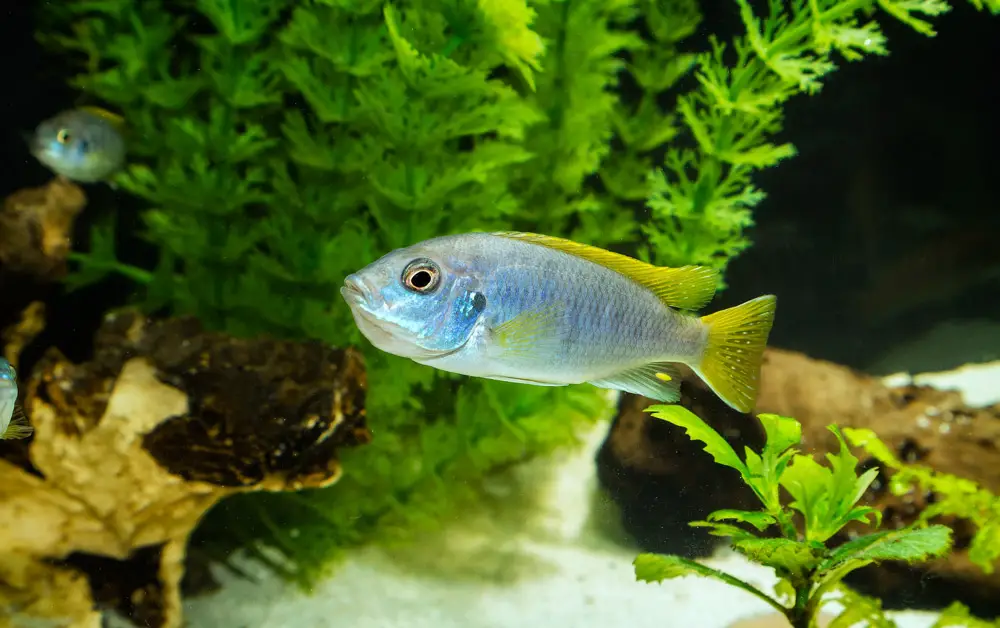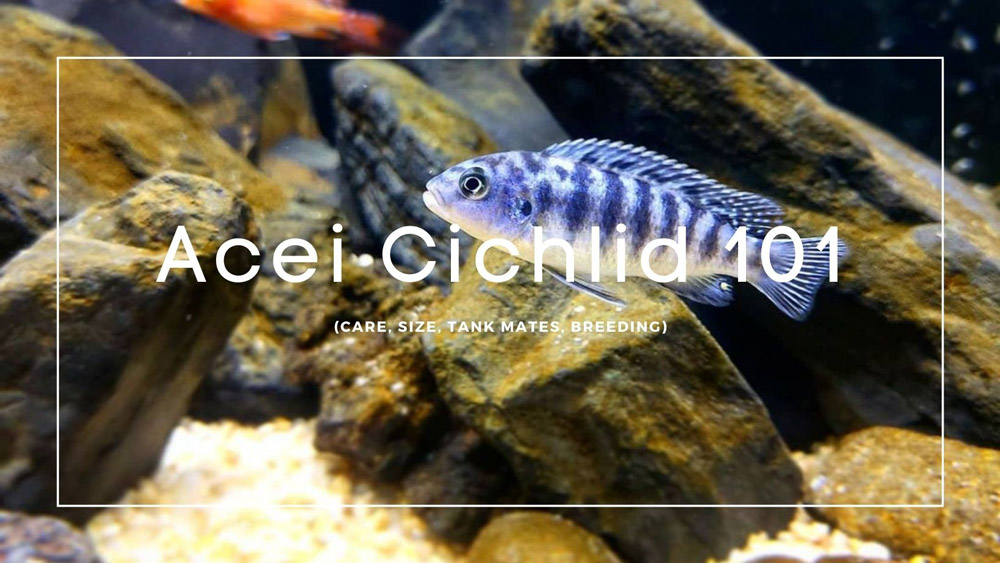While smaller fish are common in the fish-keeping community, don’t let the size fool you. As a member of Mbuna cichlids, this fish can be pretty aggressive and territorial when fully grown, whether with their own species or other tank mates. However, they are generally docile as young fish and will not disrupt your tank.
If you are thinking about bringing Acei Cichlid to your home, there are a few things to know about them first. So, sit back and enjoy our guide.
Species Profile
The Acei Cichlid (Pseudotropheus sp. “acei”) has a quite taxonomic history. Although this species has been known for many years, scientists or collectors have not formally described it. However, it’s actually the same as its close relative Pseudotropheus elegans and is sold as such in the aquarium trade.
Acei Cichlids are endemic to the rocky shoreline of the Northwestern coast of Lake Malawi, where they live in rocks and submerged logs.
Depending on the tail coloration, the Pseudotropheus sp. “acei” is divided into two different varieties:
- Yellow-tailed Pseudotropheus sp. “acei” (Msuli)
- White-tailed Pseudotropheus sp. “acei” (Ngara)
The former is the most common type, and the latter is becoming more and more popular in the aquarist community recently.
Personally, Acei Cichlids are one of my favorite Mbunas. Unlike most Pseudotropheus, they are relatively peaceful and easy to breed. If you’re looking for fish for your first Mbuna aquarium, the Acei Cichlid and the Electric Yellow Cichlid (Labidochromis caeruleus) are your best bet.
| Scientific Name: | Pseudotropheus sp. “acei” |
| Common Name: | Acei Cichlid, Yellow-tail Acei, White-tail Acei |
| Care Level: | Beginner |
| IUCN Red List: | Least Concern |
| Origin: | Lake Malawi, African |
| Lifespan: | 8 – 10 years |
| Max Size: | 5 inches (12.7 cm) |
| Temperature: | 73.0 to 82.0° F (22.8 to 27.8° C) |
| PH: | 7.7–8.6 |
| Water hardness: | 10 to 25 KH |
| Diet: | Omnivorous |
| Minimum Tank Size: | 55 gallons (48″ x 13″ x 21″) |
| Temperament: | Relatively Peaceful |
Appearance

The Acei Cichlid is by far one of the gorgeous, yellow-colored fish you can introduce to your tank. Its natural blue shade and vivid yellow fins form a stunning contrast against each other. Since you can generally see them swimming over the darker substrate and among submerged rocks in the tank, their gorgeous color looks even more vivid and beautiful.
Furthermore, upon looking closely, you will also find hues of purple on their bodies. This is more prominent when light directly falls on the surface of their bodies at certain angles. They also have black eyes and soft white lines on their fins.
The Pseudotropheus sp. “acei” was once classified into the genus Gephyrochromid. Like the typical Gephyrochromid species, they develop similar cuspid-like teeth in their mouths to feed on algae from submerged logs and rocks.
Male vs. Female Yellow Tail Acei Cichlid
The Pseudotropheus sp. “acei” is strongly monomorphic. It’s hard to distinguish between the sexes. However, there are some very subtle differences if you look closely enough.
Males are generally larger than females, and they have more vivid colors. They will be more aggressive and territorial with other Mbuna males and may chase their female counterparts and other species in the tank.
The best way to tell female Acei Cichlid from the male is by venting. The female has two different holes, the large one is the egg tube, and the other is her anus. On the other hand, the male has two holes of the same size – his genitalia and anus.
Acei Cichlid Size & Growth Rate
The average size of a full-grown Acei Cichlid is around 5 inches. Males are generally larger than females and can grow up to 5.9 inches (15 cm) long, while females are around 3.5 inches. There have been plenty of specimens that have exceeded this range in the wild.
Despite their small size, yellow tail aceis have a fairly fast growth rate. They grow fast until they reach maturity (1.5 – 2 inches), then their growth rate will slow down. You can expect them to get the full grown size in a little over a year.
Like any other Mbunas, their growth rate and potential size will depend upon their dominant position, diet, water quality, and sometimes genetics.
So, if you want your yellow or white tail acei to grow to their full potential size, make sure to provide them with the best possible conditions.
Lifespan
The average lifespan of an Acei Cichlid is around 8 – 10 years. However, many tank owners observe that these fishes can live for a few more years if they are taken care of and maintained optimally.
Acei Cichlid Care & Tank Setup

Acei cichlids are endemic to Lake Malawi, where they swim in schools of 30-50 individuals surrounding a large submerged root and rock. However, they tend to occur in smaller schools of 5-10 individuals in the rocky and sandy areas.
As we mentioned earlier, the Acei cichlids are one of the most peaceful of the Mbuna species, making the care is something that any beginning or experienced cichlid lover should have no trouble with.
The following sections will cover the basics of setting up a suitable environment for your Yellow Tail Acei so they’ll be healthy and thrive in your aquarium.
Yellow Tail Acei Tank Size
Our recommended minimum tank size for schools of 3-5 Yellow Acei Cichlids is 55 gallons (48″ x 13″ x 21″). Only keep one male with several females in small groups. Two males might fight to the death.
You can definitely overcrowd a Mbuna Cichlid aquarium with more fish, but try to provide at least 2 gallons per fish.
Water Conditions
When introducing this fish species to your tank, you should try to recreate the environment of their natural habitat as much as possible for them to be comfortable.
Lake Malawi is a Rift Valley lake, so the water is generally alkaline with high mineral content. The lake is also known for its stable water chemistry and clarity, with a visibility of up to 20 feet.
Unlike Central and South American Cichlids, Lake Malawi fish care is pretty tricky when it comes to water parameters. The following are the recommended levels:
- pH level: 7.7–8.6
- Temperature: 73.0 to 82.0° F (22.8 to 27.8° C)
- Water hardness: 10-15 dGH
- Ammonia: 0ppm
- Nitrite: 0ppm
- Nitrate: <20ppm
Since stress is the major cause of Malawi bloat, poor water conditions are sometimes fatal for these fish. To help you maintain stable water conditions, we recommend investing in a solid aquarium test kit to make sure you get accurate readings.
[amazon box=”B000255NCI”]Author notes: You may need a surface skimmer to help remove the waste that builds up on the surface of your aquarium.
There are many ways to attain and maintain a high pH. The easiest way is to use the high pH tap water. Well, it depends on your area. Tap water that tests high in pH is pretty common in many communities as higher pH water can help reduce copper corrosion in water pipes.
You can also add inert rocks like limestone to help maintain a high pH. What’s more, they can be used to create caves and hiding places for your fish to feel secure in their new home.
Once again, it’s essential to watch the nitrate level in your aquarium as the ammonia increases quickly as the pH rises. A higher concentration of ammonia is lethal for any fish.
Perform water changes by 20 to 50% weekly, depending on your bio load. For large water changes, it’s best to precondition to avoid fluctuation in the pH of the aquarium.
Decor
Mbuna means “rockfish” or “rock-dwelling” in Malawi, aptly describing their preferred habitat. As such, these fish are accustomed to living in an environment full of hiding places and caves.
The tank is mainly filled with rock to recreate their natural habitat in the home aquarium. Fill the tank with submerged rocks piled high up (almost to the surface of the water) to provide lots of passageways. Caves can be created by using dragon stones and African Driftwood.
Be careful, most Malawi cichlids are diggers. Make sure the structures are secure and can’t collapse and injure your yellow tail acei. It’s good to attach the rocks to the aquarium glass with silicone sealant or epoxy resin glue instead of putting them on the substrate.
We recommend using a darker substrate to help Mbunas feel safe and show their best coloration. An excellent way to achieve this is to use black diamond blasting sand.
Diet & Food
Remember that Yellow tail acei is an herbivore and principally feeds on algae in the wild.
In the aquarium, a good quality spirulina-based flake should be the primary source of their diet. The OSI Spirulina flake is an excellent choice.
[amazon box=”B00025K0MG”]You can also supplement their diet with blanched vegetables like frozen peas, romaine lettuce, broccoli, and cucumber.
An occasional treat of “meaty” foods such as Mysis shrimp, Daphnia, and bloodworms can be offered, but avoid these more than about once a week.
As with all Malawi cichlids, it’s recommended to fast them once a week to maintain their health.
Yellow Tail Acei Tank Mates
Like any other Mbunas, the Yellow Tail Acei is not considered to be a community fish.
In terms of compatibility, yellow tail acei is a moderately aggressive Mbuna. They are best to be housed in schools of at least 3-5 fish in a “peaceful” Mbuna aquarium in order to be happy.
You can only have one male with several females to form a harem situation in small groups. If you have more than one male in a small tank, they will likely fight and even kill each other.
In all Mbuna aquariums, large-sized species like P. crabro (Bumblebee cichlid) should be avoided. Mbunas with similar coloration and patterning, as well as other hugely belligerent species from Maylandia, Labeotropheus, and Tropheops should also not be kept with yellow tail acei.
Some possible tank mates for yellow tail acei include:
- Electric yellow cichlid (Labidochromis caeruleus)
- Rusty Cichlid (Lodotropheus sprengerae)
- Red Top Hongi (Labidochromis sp.)
- Pearl of Likoma (Pseudotropheus joanjohnsonae)
- Cynotilapia zebroides
- Aulonocara spp
- Copadichromis spp
Breeding
This fish species is an ovophile mouth brooder, which means that the female yellow tail acei will protect the eggs in her mouth until they hatch and are free swimming.
Mouth brooders are considered to be one of the easiest African cichlids species to breed in captivity.
The female will spawn on flat surfaces like rocks. Moreover, the females will incubate and hatch eggs in her buccal pouch, carrying them for about 25 days.
Final Thoughts
If you plan on breeding Acei Cichlid, ensure that you feed them well and keep them in a proper environment. This fish species have long intestines and do not eat much, but you need to keep a keen eye on their appetites to ensure they do not have Malawi Bloat.
The Acei Cichlids are sometimes found online with a moderate price tag, but prices may vary depending on the retailer. If you’re lucky, you can also pre-order these fish at your LFS during the season.
We hope you enjoyed reading this article, and please feel free to leave us a comment below if you have any questions or would like to share your experiences with yellow tail acei cichlids.
Best of luck!
